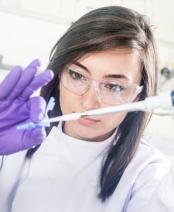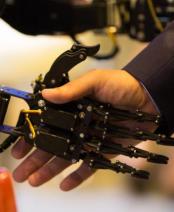When bacteria become resistant

"Antibiotics are not automatic". Everyone remembers this French Health Insurance slogan, widely circulated in 2002. Behind this clever formulation lies a major public health problem: antibiotic resistance. Although international agencies such as the World Health Organization (WHO) have been raising awareness and encouraging governments to take action for the past 20 years, the effects have yet to be felt. The OECD and the French public health agency Santé Publique France, for example, estimate that, as things stand, some 240,000 people could die by 2050 (1) in France as a result of pathogenic bacteria adapting to antibiotics.
A frontier object
In November 2023, the Institut Polytechnique de Paris (IP Paris) launched its first seminar dedicated to antibiotic resistance and, more broadly, antimicrobial resistance (AMR - occurs when a bacterium, virus, fungus or parasite no longer responds to drugs). Supported by its E4H (Engeeniring for Health) center for health engineering, the project's watchword is interdisciplinarity, and it is implementing a new dynamic of research and collaboration. Indeed, the challenges are multiple: scientific, to understand the fundamental mechanisms of resistance, pharmacological to develop new molecules, but also economic and public policy.
"From the point of view of the social sciences, AMR is a frontier object. In other words, it's a subject of study that can't be confined to a single science or a single group of researchers," explains Jocelyne Arquembourg, Emeritus Professor of Information and Communication Sciences in the Department of Social Sciences and Management at IP Paris. "There are skills here in chemistry, biology, mathematics, artificial intelligence and physics that were not previously mobilized around AMR. The approach we are initiating will pool potential and cross-fertilize approaches. It's highly motivating. The information and communication sciences complement this strike force with the historical vision they provide on the emergence of AMR and the evolution of society's view of antibiotics. They open up new perspectives on how to tackle the problem.
Miracle molecules or pollutants?
A look in the rear-view mirror. For several decades after the end of the Second World War, antibiotics were seen as miracle products, helping to cure certain fatal diseases (such as tuberculosis) or sexually transmitted diseases, and facilitating surgery. In their early days, they even abounded in ointments and eye drops, and were used to preserve foodstuffs. At the same time, their role as growth promoters in livestock breeding was proven. They were then added to animal feed, without veterinary intervention, and went far beyond the sphere of human health.
The dissemination of these molecules puts pressure on bacteria, which develop strategies to survive them. All the ingredients are there for antibiotic resistance to take hold. Alexander Fleming, the father of penicillin, himself recognized the phenomenon in the columns of the newspaper Le Monde in 1953. "With a decade's hindsight on the use of antibiotics, he saw no harmful impact on human health and suggested that all that was needed to manage antibiotic resistance was to stay ahead of the bacteria's strategy, a doctrine followed by scientists right up to the 1990s, with the steady development of new generations of antibiotics", emphasizes Jocelyne Arquembourg.
When certain patents fall into the public domain, the big pharmaceutical groups turn away from the development of new molecules, for lack of profitability. Innovation then falls to start-ups, but their power is much more limited. At the same time, Scandinavian consumer associations recognized the health hazard posed by the use of antibiotics in livestock farming. They campaigned for their abandonment, and were heard by the European Union, which banned them as a growth promoter in 2006 (the United States followed suit 10 years later). "Society has changed the way antibiotics are used and the regulatory framework around them.Today, the presence of some antibiotics is even monitored and quantified in water and soil". This is the case, for example, with sulfamethoxazole, which will be included in the European Water Framework Directive in 2020, and in the French list of specific pollutants for ecological status in April 2022 (2). "We're a long way from the miracle antibiotic of the post-war era," ironizes the professor emeritus. It should be noted that, in addition to the molecules excreted into the environment by humans and animals undergoing antibiotic therapy, the genetic material of bacteria that have acquired resistance is also dispersed in their digestive tracts.
Unique health
The health of ecosystems is now largely included in the scope of antibiotic resistance, alongside human and animal health. Indeed, since 2015, the WHO has been urging governments to tackle the problem head-on under a holistic approach (One Health) by considering all three areas. While an international dynamic has been launched via certain states (Germany and Great Britain in particular), it's impossible to ignore regional specificities in implementing effective measures. "In France, for example, an interministerial roadmap was published in 2016. Prevention and monitoring actions are multiplying (Priority Antibiotic Resistance Research Program, Promise network, Ecoantibio plans...) but the issue of water monitoring will not be possible without the commitment of local elected representatives."
The aim of the Institut Polytechnique de Paris is therefore to bring together the innovative viewpoints of researchers, economic players and associations, as well as specialists in the implementation of public policies. Like global warming, antibiotic resistance, and more broadly antimicrobial resistance, raises complex issues: who can act? how? who suffers? "This means that we need to recalibrate our research practices and their implementation, for example, by promoting a two-way flow between the laboratory and civil society, and thus respond effectively to societal expectations. Our action must nurture the dialogue that will eventually bridge the gap between scientists who warn on the one hand, and public players who are groping their way along on the other, lacking the factual elements to guide their public policies", concludes Jocelyne Arquembourg.
About:
Jocelyne Arquembourg is Associate Researcher at Télécom Paris and Professor of Information and Communication Sciences at Sorbonne Nouvelle University. She works on the mediatization and communication of public health issues, in particular antibiotic resistance. She has published numerous articles on the subject, and was a member of the JPIAMR scientific committee, Dr. Carlet's report, and the Priority Research Program on antibiotic resistance.














